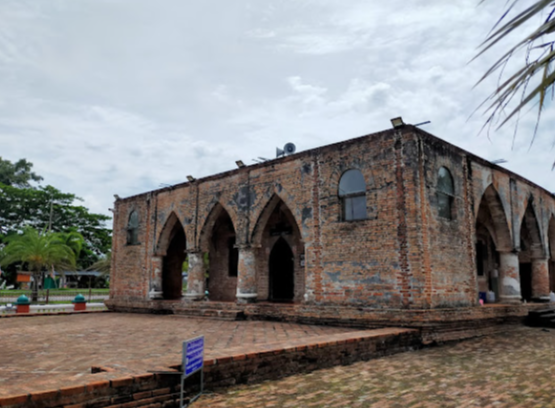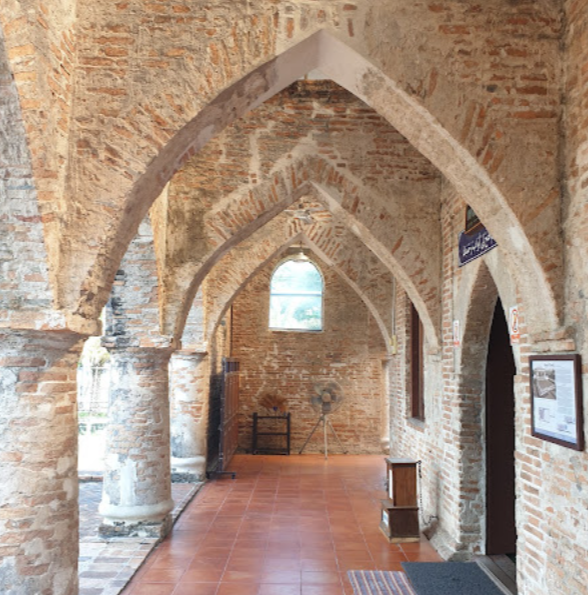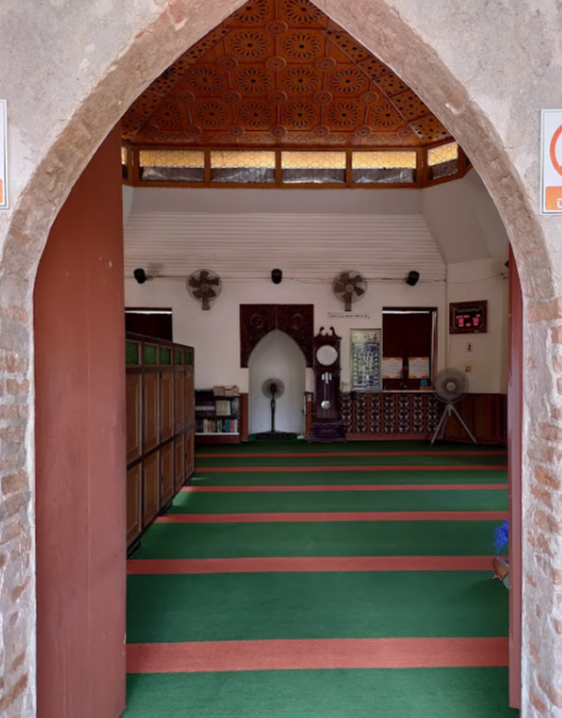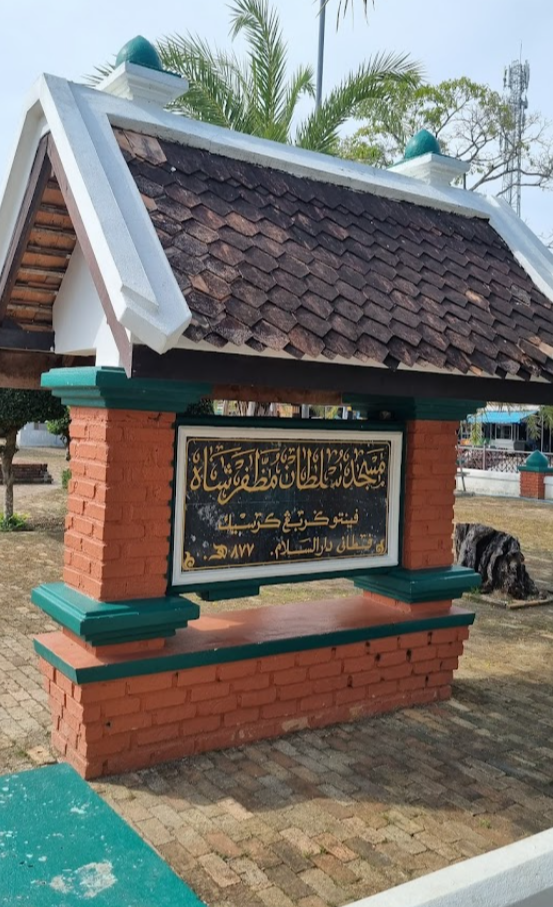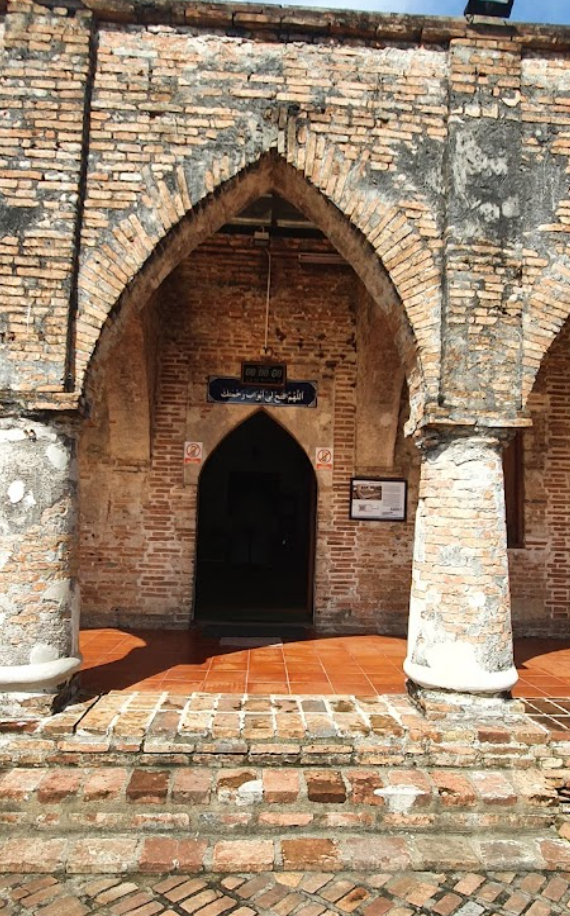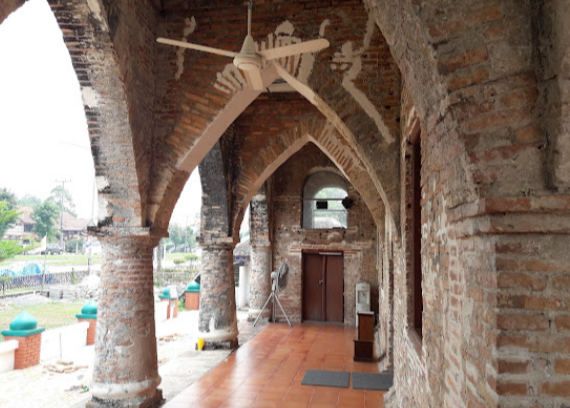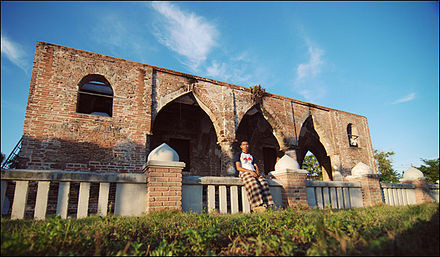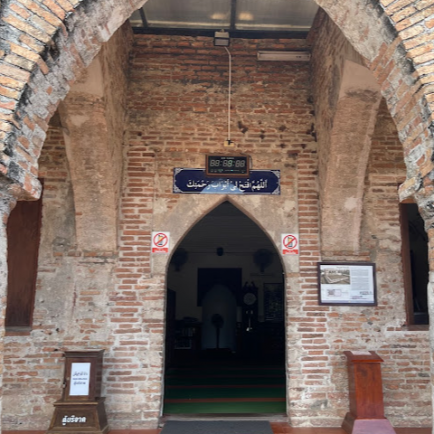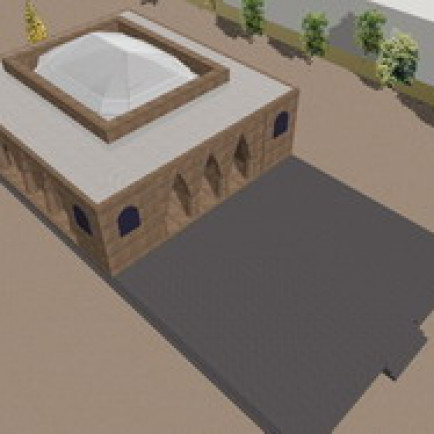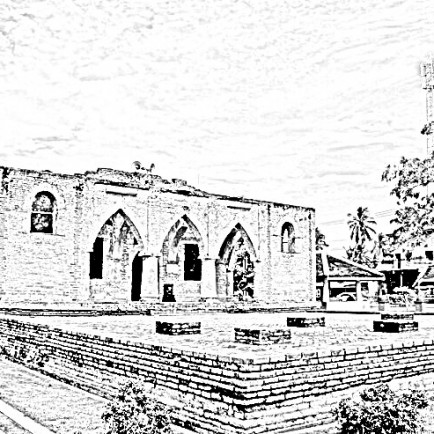Krue Se Mosque
History
It is unclear when the mosque was first constructed, although a mosque may have been rebuilt several times at the same location. According to Hikayat Patani, a history of the Pattani Kingdom, two mosques were constructed during the reign of Sultan Muzaffar Shah (d. 1564). One of the mosques was built outside the main gate ("Pintu Gerbang") of the citadel beside the town square (padang), likely the location of the present Krue Se Mosque.
It is also said that it was built around the time of the Ayutthaya king Naresuan the Great, but left incomplete due to a power struggle between the Sultan of Patani and his brother. Some believe that the mosque was built by the Chinese pirate Lim Toh Khiam, who according to local lore married the daughter of the Sultan of Patani, claimed to be Raja Hijau, and converted to Islam.
Next to the mosque is a garden as well as the gravestone of Lim Ko Niao, said to be the sister of Lim Toh Khiam, who in this tale placed a curse so the dome of the mosque could not be completed.
A mosque was known to be have been constructed by the early 17th century; Jacob van Neck wrote in a Dutch report in 1603 that the then principal mosque of Patani "was very neatly constructed by Chinese workers from red bricks".
The mosque may have been left in ruins after Pattani was captured and sacked by the Siamese in 1785, and the centre of Pattani was later relocated a few miles west to its present location. An attempt to repair or rebuild the mosque was undertaken in the 19th century by Tuan Sulong who governed Pattani from 1816 to 1832.
The mosque became known as Krue Se Mosque (Masjid Kerisik in Malay) after the Ban Krue Se (Kampung Kerisik) area it is located. The mosque was designated a historical site by the Department of Fine Arts of Thailand in 1935 and a minor renovation was undertaken two years later. Major restoration works on its structure were conducted in 1957 and 1982. Further renovation was completed in 2005.
Urban and Architectural
The architectural style of the mosque is of Arab-Persian-Turkish architecture. causing doubts as to who designed this mosque. Or where did you take (remember) the architectural style? In this question, Hikaya Patani, referring to the Sheikh Safi Yuddin, who proposed to the Sultan to build a mosque, was a Pasay (Ajeh). Supporting the possibility of more than Lim table Kiem to be the designer or bring the architectural style from China. Pasay, or Aceh, has been closely associated with the Arab-Persian-Turkish culture since before the 16th century. The transmission of Middle Eastern arts and culture through India to Aceh and to Patani is more than likely a mere possibility. send through china In addition, the early mosque architecture style in China was a Chinese art architecture that used wood as a building material. Therefore, it does not weigh much to believe that Lim Tho Kiem designed or brought the mosque's design from China. In the story of Chao Mae Lim Ko Niao, the Kananurak family version, it is said that Lim Toh Kiem was the director of the mosque. This may mean that the mosque was not designed or implemented. And if these two legends have reliable information on the construction of mosques It is also possible that Shaykh Safiyuddin from Pasay designed or brought the architectural style of the mosque from Pasay to Patani and Lim Tok Kiem supervised the construction of the building in one of the duties as assigned. Baked from the Sultanate of Patani It remains to be checked whether both Shakesa Fyuddin and Lim Tho Kiam came to Patani during the same period. Shaykh Safiyuddin from Pasay designed or brought the architectural style of the mosque from Pasay to Patani and Lim Tok Kiem supervised the construction of the building in one of the duties as assigned. Baked from the Sultanate of Patani It remains to be checked whether both Shakesa Fyuddin and Lim Tho Kiam came to Patani during the same period. Shaykh Safiyuddin from Pasay designed or brought the architectural style of the mosque from Pasay to Patani and Lim Tok Kiem supervised the construction of the building in one of the duties as assigned. Baked from the Sultanate of Patani It remains to be checked whether both Shakesa Fyuddin and Lim Tho Kiam came to Patani during the same period.
The
architectural details of Krue Se Mosque, as far as the analysis is concerned, can be seen from the arches between the pillars of Krue Se Mosque, a different arching technique known as equilatural arch or Gothic arch. From the arches of the ancient mosque of Ban Da Toh, Masjid Raya Chabangtikor, and Masjid Raya Saiburi using Round Arch technique, it can be said that Krue Se Mosque was built in a different era from the mosque at Dato and Both Raya Mosques Equilatural arch or Gothic arch has been used at Phra Narai's Palace at Lop Buri and the Thep Mee Bridge in Ayutthaya, which many scholars believe was influenced by Persia. And it was in the age after the Krue Se Mosque was not much
.
Mirhab, or western porch for the imam to pray at Krue Se Mosque, is a arched niche in the style of the meh-round of a mosque in the Middle East. This is different from the meah that is popular in Southeast Asia or the Malay world (Nusantara) or even the Chinese that make meah around in a square booth. It is another thing that can be assumed that the architectural style of Krue Se Mosque is influenced by Arab-Persian-Turkish
.
One of the similarities of the early mosques in the Malay world that differed from the mosques in India-Persian-Arab and Turkey is that mosques in this area were not popular to build minaret. A case study in this regard can be found at Other first mosques, such as the Ah Ho Mosque in Pattani The Kampong Lao Mosque at Kelantan and the Agung Mosque in Demak on Java Island Krue Se Mosque also does not appear minarets. This is enough to define a broad age and era of architecture. These mosques without minarets use drums to signal the time of prayer. Until when it was heavily influenced by the Arab world during the 20th century, later minarets were added such as Kampong Lao Mosque, Agung Mosque, and Raya Chabangtika Mosque. and Talo Mano Mosque,
Description
Krue Se Mosque or Sultan Musaffar Shah Mosque It is an old mosque over 200 years old in Pattani It can be assumed that it is a religious place built in the 22nd Buddhist century in the contemporary with Ayutthaya period. There is another name. Pitukrueban Mosque This name is named after the shape of the mosque's door. Which looks like a pointed arc in the Gothic style of the Europeans. and the architecture of the Middle East (the word Pitu means a door, Krueban means an arched doorway)
Details
Location
Krue Se, Tanyong Lulo, Mueang Pattani District, Pattani 94000, Thailand
Worshippers
100
Owners
Sultan Muzaffar Shah
Year of Build
16th century
Area
230
Drawings
Map
History
It is unclear when the mosque was first constructed, although a mosque may have been rebuilt several times at the same location. According to Hikayat Patani, a history of the Pattani Kingdom, two mosques were constructed during the reign of Sultan Muzaffar Shah (d. 1564). One of the mosques was built outside the main gate ("Pintu Gerbang") of the citadel beside the town square (padang), likely the location of the present Krue Se Mosque.
It is also said that it was built around the time of the Ayutthaya king Naresuan the Great, but left incomplete due to a power struggle between the Sultan of Patani and his brother. Some believe that the mosque was built by the Chinese pirate Lim Toh Khiam, who according to local lore married the daughter of the Sultan of Patani, claimed to be Raja Hijau, and converted to Islam.
Next to the mosque is a garden as well as the gravestone of Lim Ko Niao, said to be the sister of Lim Toh Khiam, who in this tale placed a curse so the dome of the mosque could not be completed.
A mosque was known to be have been constructed by the early 17th century; Jacob van Neck wrote in a Dutch report in 1603 that the then principal mosque of Patani "was very neatly constructed by Chinese workers from red bricks".
The mosque may have been left in ruins after Pattani was captured and sacked by the Siamese in 1785, and the centre of Pattani was later relocated a few miles west to its present location. An attempt to repair or rebuild the mosque was undertaken in the 19th century by Tuan Sulong who governed Pattani from 1816 to 1832.
The mosque became known as Krue Se Mosque (Masjid Kerisik in Malay) after the Ban Krue Se (Kampung Kerisik) area it is located. The mosque was designated a historical site by the Department of Fine Arts of Thailand in 1935 and a minor renovation was undertaken two years later. Major restoration works on its structure were conducted in 1957 and 1982. Further renovation was completed in 2005.
Urban and Architectural
The architectural style of the mosque is of Arab-Persian-Turkish architecture. causing doubts as to who designed this mosque. Or where did you take (remember) the architectural style? In this question, Hikaya Patani, referring to the Sheikh Safi Yuddin, who proposed to the Sultan to build a mosque, was a Pasay (Ajeh). Supporting the possibility of more than Lim table Kiem to be the designer or bring the architectural style from China. Pasay, or Aceh, has been closely associated with the Arab-Persian-Turkish culture since before the 16th century. The transmission of Middle Eastern arts and culture through India to Aceh and to Patani is more than likely a mere possibility. send through china In addition, the early mosque architecture style in China was a Chinese art architecture that used wood as a building material. Therefore, it does not weigh much to believe that Lim Tho Kiem designed or brought the mosque's design from China. In the story of Chao Mae Lim Ko Niao, the Kananurak family version, it is said that Lim Toh Kiem was the director of the mosque. This may mean that the mosque was not designed or implemented. And if these two legends have reliable information on the construction of mosques It is also possible that Shaykh Safiyuddin from Pasay designed or brought the architectural style of the mosque from Pasay to Patani and Lim Tok Kiem supervised the construction of the building in one of the duties as assigned. Baked from the Sultanate of Patani It remains to be checked whether both Shakesa Fyuddin and Lim Tho Kiam came to Patani during the same period. Shaykh Safiyuddin from Pasay designed or brought the architectural style of the mosque from Pasay to Patani and Lim Tok Kiem supervised the construction of the building in one of the duties as assigned. Baked from the Sultanate of Patani It remains to be checked whether both Shakesa Fyuddin and Lim Tho Kiam came to Patani during the same period. Shaykh Safiyuddin from Pasay designed or brought the architectural style of the mosque from Pasay to Patani and Lim Tok Kiem supervised the construction of the building in one of the duties as assigned. Baked from the Sultanate of Patani It remains to be checked whether both Shakesa Fyuddin and Lim Tho Kiam came to Patani during the same period.
The
architectural details of Krue Se Mosque, as far as the analysis is concerned, can be seen from the arches between the pillars of Krue Se Mosque, a different arching technique known as equilatural arch or Gothic arch. From the arches of the ancient mosque of Ban Da Toh, Masjid Raya Chabangtikor, and Masjid Raya Saiburi using Round Arch technique, it can be said that Krue Se Mosque was built in a different era from the mosque at Dato and Both Raya Mosques Equilatural arch or Gothic arch has been used at Phra Narai's Palace at Lop Buri and the Thep Mee Bridge in Ayutthaya, which many scholars believe was influenced by Persia. And it was in the age after the Krue Se Mosque was not much
.
Mirhab, or western porch for the imam to pray at Krue Se Mosque, is a arched niche in the style of the meh-round of a mosque in the Middle East. This is different from the meah that is popular in Southeast Asia or the Malay world (Nusantara) or even the Chinese that make meah around in a square booth. It is another thing that can be assumed that the architectural style of Krue Se Mosque is influenced by Arab-Persian-Turkish
.
One of the similarities of the early mosques in the Malay world that differed from the mosques in India-Persian-Arab and Turkey is that mosques in this area were not popular to build minaret. A case study in this regard can be found at Other first mosques, such as the Ah Ho Mosque in Pattani The Kampong Lao Mosque at Kelantan and the Agung Mosque in Demak on Java Island Krue Se Mosque also does not appear minarets. This is enough to define a broad age and era of architecture. These mosques without minarets use drums to signal the time of prayer. Until when it was heavily influenced by the Arab world during the 20th century, later minarets were added such as Kampong Lao Mosque, Agung Mosque, and Raya Chabangtika Mosque. and Talo Mano Mosque,
Description
Krue Se Mosque or Sultan Musaffar Shah Mosque It is an old mosque over 200 years old in Pattani It can be assumed that it is a religious place built in the 22nd Buddhist century in the contemporary with Ayutthaya period. There is another name. Pitukrueban Mosque This name is named after the shape of the mosque's door. Which looks like a pointed arc in the Gothic style of the Europeans. and the architecture of the Middle East (the word Pitu means a door, Krueban means an arched doorway)


